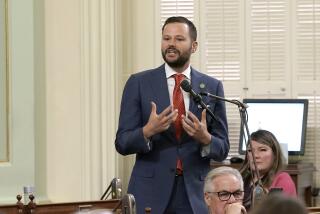Telecommuting Center Coaxes Workers Off Road and Online
- Share via
As a researcher for the Los Angeles County law firm of Greene, Broillet, Taylor & Wheeler, Steve Youmans used to commute from his home in Ventura to his office in East Los Angeles every workday.
That, he said, often meant returning just in time to see his three children fall asleep.
But more recently, Youmans has seen his sons battle it out in after-school hockey contests and watched his 9-year-old daughter take part in dance recitals. He’s helped with homework and spent time with them before bed.
It’s a change of lifestyle that he credits to spending less time commuting and more time telecommuting.
Three or four days each week for the past year, Youmans has worked from a high-tech, computerized workstation at the Ventura College Educational Telecommuting Center, housed in a trailer on campus.
Last month, the Ventura College program was awarded a $48,000 grant by the Southern California Telecommuting Partnership program to provide free training and education to Ventura County business managers and their employees.
On Wednesday, the center’s four workstations and one fully equipped office space will be open to the public during its first anniversary open house. The center, located on Central Campus Drive near Guthrie Hall, will be open from 1 to 7 p.m.
The Ventura center is among a dozen public facilities involved in the five-county partnership, a year-old project aimed at promoting the economic benefits of having employees work at home or at sites near home, rather than commuting to work daily.
Formed in 1994, the partnership covers Ventura, Los Angeles, San Bernardino, Riverside and Orange counties. It is funded by a $1.5-million grant from the U.S. Department of Commerce, a portion of which is being provided to Ventura College for its educational program.
“Our grant will be used to develop curriculum and to do a pilot program with public and private businesses, to train managers and to help them overcome their fears of telecommuting,” said Candace Robinson, site administrator for the Ventura College center.
Robinson, along with Marcelino DeCierdo, dean of Ventura College’s Economic and Community Development Program, also handles the marketing and promotion duties for a telecommuting center at Moorpark College. The Moorpark program is also part of the Southern California partnership.
At each college, every workstation comes equipped with a personal computer with CD-ROM capability, a printer, a modem, a telephone and, as of last week, Internet access. Workers also have access to a conference room, a copy machine, a fax machine, a paper shredder and other office accommodations.
At each facility, space is leased for $50 to $250 per month, depending on the number of days used. There is rental of $7.50 per hour or $20 per day for occasional use.
The Ventura telecommuting center costs about $75,000 annually to operate, said Robinson. In addition to the $48,000 study grant, the Ventura program is funded by a $40,000 annual Caltrans grant and by Ventura College, which pays the program’s overhead and administrative costs.
At Moorpark, the annual $55,000 operating cost is covered primarily by another $40,000 Caltrans grant, with the college covering the remainder.
Robinson said six workers rent space on a regular basis at Ventura College, and the center has a steady flow of drop-in clients.
The Moorpark program, she said, has four regulars and only a few drop-ins. The center’s out-of-the-way location, on the top floor of the Moorpark College library, severely curtails drop-in use, she said, but plans are in the works to heavily promote the program in coming months.
“With the technology out there now, there are very few jobs that don’t lend themselves to telecommuting at least one day a week, or one day a month,” Robinson said. “But managers are afraid that if they can’t see the employees at the job, the employees won’t be working.”
Robinson said the training program would help alleviate those fears.
“Telecommuting is just good business management,” she said. “Morale of telecommuting employees tends to go up. Production tends to go up. Telecommuters have less distractions.”
Not having to commute great distances through congested traffic saves on wear and tear on one’s body and one’s vehicle, decreases stress and puts to better use the time that would have been spent commuting, she said.
For the employer, Robinson said, telecommuting can be a money-saving practice as well. “If a company has problems with space for all its workers,” she said, “they can save money with telecommuters and not have to expand, or maybe even downsize.”
In the case of Youmans, working from an office close to home much of the week, rather than driving 70 to 75 miles to work each day, saved his law firm money on gas and cellular phone bills, more than offsetting the worksite rental space, he said.
Last month, Youmans said, he spent $500 on gas, compared with $1,200 in January 1995. During the same time period, he said, his cellular phone bill dropped from $600 to $0.
Robinson said her center’s pilot program will tell employers how to structure their businesses to allow for telecommuting; help employers determine which employees and jobs are best suited for telecommuting; explain workers’ compensation, liability and other workplace laws with regard to telecommuting, and train employees on how to set up workstations and how to best manage their time.
“Obviously, not all positions would lend themselves to telecommuting,” said Alan Holmes, a Ventura County account executive for Southern California Rideshare. “If you’re the fifth guy on an assembly line, it wouldn’t work. But as we get more and more into a service-oriented economy, we can be more and more served by telecommuting.”
Holmes follows the advance of telecommuting primarily in terms of its effect on air pollution and traffic congestion.
“Fifty percent of our ozone problem is created by driving to work in the morning,” he said. “And the more vehicle trips we can reduce, the better traffic flow will be, and hopefully we will not have to widen roads any sooner than we need to.”
More to Read
Inside the business of entertainment
The Wide Shot brings you news, analysis and insights on everything from streaming wars to production — and what it all means for the future.
You may occasionally receive promotional content from the Los Angeles Times.










